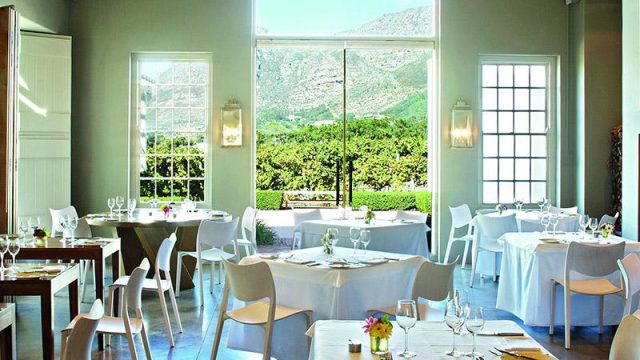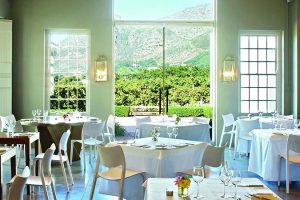When most visitors to Cape Town begin planning a day out in the winelands, chances are their thoughts turn to the historic estates of Stellenbosch, the stellar sun-soaked vineyards of Paarl or the glamorous wineries of Franschhoek.
Further afield, the Cape has even more to offer: cool-climate Sauvignon Blanc and Riesling in Elgin, an echo of Burgundy in the elegant Chardonnay and Pinot Noir of the aptly-named Hemel-en-Aarde (“Heaven and Earth”) Valley outside Hermanus, and the rustic rural feel of the expansive Breede River Valley with its fine champagne-style bubblies.
And yet few visitors think to explore what’s all but staring them in the face: Look closely as you explore the Mother City and you’ll find trellised vineyards throughout your travels.
There’s the tiny Clos d’Oranje above the City Bowl, a scrap of vineyard near Kalk Bay Harbour and, of course, the manicured vines of Constantia. And that’s just for starters. The area is becoming such a key wine-making region that the regulatory body for the industry recently established the Cape Peninsula wine ward to designate wines crafted from grapes grown here where the combination of granite soils and cooling sea breezes temper the hot summer sun and add a welcome elegance to the region’s wines.
The very roots of the South African wine industry began in these fields that are today just a 20-minute drive from the bustling streets of downtown Cape Town. Hop on the M3 and head south around the rump of the mountain – with the mountain on your right – and before long the familiar barrel-and-glass motif will start appearing on the roadside information boards. When you hit Constantia, hang a right and head for the hills.
The Constantia Valley is home to both the historic stalwarts of the local wine industry alongside a host of exciting young upstarts grabbing gold medals both locally and abroad.
The expansive Groot Constantia estate has a rich and varied history, with an on-site museum and two restaurants looking after the swarms of tourists that flock here in the summer. And that is, sadly, part of the problem. Although the wines aren’t bad, the feel is more of a tourist attraction than a winery.
However, that’s not the case at the new crop of boutique offerings that have transformed pine-covered mountainside into acres of manicured vine. Eagle’s Nest is a personal favourite, with its shady lawn and terrace tables. Its wines have also garnered plenty of praise, particularly the award-winning Shiraz and Viognier. Nearby, Constantia Glen’s Bordeaux-style red and white wines consistently score four-stars and above in South Africa’s respected Platter’s Guide, while High Constantia has a particularly good reputation for Sauvignon Blanc.
If you’re after a more intimate experience, with a good dollop of history to boot, hop back in your car for a 10-minute drive around the vineyards to Klein Constantia.
Home of the lauded sweet wine ‘Vin de Constance’ – drunk by everyone from Charles Dickens to Napoleon – today the cosy tasting room offers an expert guided tasting through the estate’s wide range of wines. They’re particularly strong on their white wines, and do ask to hear the story behind the exceptional Perdeblokke Sauvignon Blanc from a single vineyard high on the Constantiaberg. They also have the wonderful Marlbrook red blend, as well as a very good Méthode Cap Classique: the local term for sparkling wine made in the same method – a second fermentation in the bottle, to provide the bubbles – as champagne.
While the neighbouring estate of Buitenverwachting has excellent red wines and top-drawer Sauvignon Blanc – and a lovely picnic offering in summer – you wouldn’t be blamed for rushing straight along to Steenberg Estate, at the southern end of the valley.
One of the oldest farms in the Cape is today one of its most exciting, with an ever-changing array of food, wine and lifestyle experiences. The hotel and spa on the estate has been ranked amongst the best in Africa by the likes of Condé Nast Traveller, and the Steenberg Golf Club is a particularly good layout by acclaimed architect Peter Matkovitch.
The estate also offers two wonderful eateries: Catharina’s pays homage to the matriarch that first settled here in the late-1600s, and under the knife of chef Garth Almazan it offers an inspired menu of Cape bistro cooking in an upmarket setting.
At the top of the estate, the airy and modern Bistro1682 sits alongside the winery with yet more modern Cape food with a few globetrotting flavours thrown in for good measure.
The wine-tasting centre is an airy light-filled space alongside the cellar where winemaker JD Pretorius crafts his exceptional Sauvignon Blanc and Semillon. If your palate’s more suited to red wines, the Steenberg Nebbiolo is a rarity well worth tasting.
The grapes from the tiny vineyard at Kalk Bay are turned into a quaffable Cabernet Franc served at the village’s famed Olympia bakery, or keep driving around the limestone peaks and turn north for the village of Noordhoek.
Just before the famous Chapman’s Peak scenic drive, the vines of Cape Point Vineyards are easy to spot running high on the flanks of the Constantiaberg. Dramatically exposed to the sea breezes blowing in off the icy Atlantic, they lend plenty of fresh minerality to the remarkable Sauvignon Blanc, Chardonnay and Isliedh Sauvignon/Semillon blend.
Although the restaurant alongside the tasting room is a good bet for day-trippers, the real secret here is the weekly Thursday night market, when artisanal food stalls set up shop and the locals descend on the estate for great wine, good food and one of the best sunset views Cape Town has to offer.
Or, you can keep exploring. There are a handful of other vineyards hidden around the Peninsula, so if you’re an ardent vinophile then pick up a Platter’s Guide and call ahead to taste the Rhône style reds of Hout Bay Vineyards, the remarkable cap classique of Ambeloui, or the Syrah of the city bowl winery Signal Hill.




